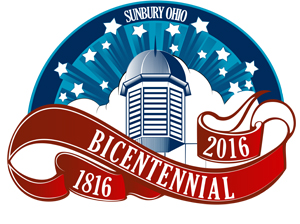| From The Sunbury News, January 21, 2016: |
|
| Because You Asked . . . . | |
|
Why Sunbury? |
|
|
By Polly Horn, Curator of the Myers Inn Museum |
|
|
Carleton and Dilly Burrer had a passion for learning the derivation of the name Sunbury. They spent many vacations traveling to Sunburys in the USA as well as in England. There is also a Sunbury in Australia. They all seem to come from Sunbury-on-the-Thames in England. Burrers traced the name Sunbury to a document called "Sunbury Charter" and found the "Saxons were, in fact, the true founders of Sunbury. We know this through a remarkably informative Saxon document known as the "Sunbury Charter," by which King Edgar (959-980) granted to his faithful kinsman Sunna "in perpetuity, a certain parcel of land, called Sunnaís Burh and Sunnaís Haw. The Charter's description hinges on its reference to "Sunna's
Burh" and "Sunna's Haw." These Saxon terms suggest that it was a
Saxon lord, called Sunna who founded the community and gave it his
name. It was passed on to Sonning and Sunningdale. Sunna settled his
followers around his own palisaded residence. "However, I believe
the word "burh" to be a corruption of the word "beorg" or hill", and
refers to the distinctly higher ground around the Vicarage, which
would have been even more prominent in those far off days. At any
rate, whatever the truth, we can see how Sunna's Burh evolved, by
the time of the Charter, to Sunnanbyrig, and within a hundred years
to Suneberie; and, finally in the course of centuries, to Sunbury,"
wrote Carleton Burrer. More of this is available at The founder of Pennsylvania, William Pennís father Admiral Sir William Penn was very popular and was knighted in England for winning so many naval battles. Upset about young Williamís conversion to Quakerism, the Admiral told his son he was disinherited. However before the Admiral died they reunited. The father ask the King to be sure to take care of his son. William inherited his fatherís property and money then in 1681, King Charles II granted to William Penn, first proprietary lands and governor of what was to become Pennsylvania. After Williamís death his sons Richard and John from Middlesex, England, which included the Parish (Manor) of Sunbury, laid out the 'Manour of Sunbury', established as a Proprietor's holding. It was located in the Wyoming Valley in Pennsylvania from 1768 to 1813, and encompassed the same area from whence our earliest pioneer families to settle in Delaware County, Ohio. Sunbury traveled from England to Pennsylvania. It is a matter of record that a Carpenter Family, naming especially Benjamin and Gilbert Carpenter who were very prominent in the early history of Luzerne County; Forty Fort, Kingston and Wilkes Barre area along the upper Susquehanna River in Pennsylvania came to Delaware County before the townships were named. Gilbert Carpenter was a builder and was an early grist-mill builder and owner. Ezekial Brown, also a resident of Luzerne Co., had earlier moved to Franklin Co., Ohio. Benjamin Carpenter, in JuIy 1806, purchased 2 tracts of land in Delaware County, Ohio, from Col. Byxbe before leaving Pennsylvania. He and his brother Gilbert sold considerable property owned in the Wyoming Valley area and moved in 1807 with their families to the tracts in Delaware County which, soon afterward, became part of the newly established Sunbury Township. Many families moved to central Ohio Counties in 1807. On February 10, 1808, Delaware County was set off from Franklin County, by act of The Ohio Legislature, and it was directed that on the first Monday, May 1808 there was to be an election held to elect Commissioners and other County Officers. The Act authorized Associate Justices, Moses Byxbe, Thomas Brown, and Josiah McKinney to divide the County into Townships. They divided it into three - Berkshire, Radnor, and Liberty. Then on June 16, 1808 the Commissioners formed Sunbury Township, which encompassed all the balance of the County not previously laid out. Sunbury Township consisted of what is now Harlem, Trenton and Porter Townships and the east one-half of Kingston, Berkshire and Genoa. On the north, it included all the area east of Marlboro Twp., i.e., what is now Bennington, Harmony, Peru and Lincoln Townships of Morrow County; having as the northernmost border, the Indian (Greenville) Treaty Line, east to its junction with the Sixteenth the Eastern Line of Delaware County. There is no way to know who suggested the name Sunbury but all of them would have been familiar with Richard Pennís Sunbury Manor. Berkshire Township, prior to 1806, was a part of Sharon Township, Franklin County, Ohio, and its boundaries had changed from time to time, until by the efforts of Major Thomas Brown, it was then organized as a separate Township to include parts of what is now Brown, Kingston, Berlin, Orange Twps., and the west half of Genoa and the present Berkshire Township. It was stated to have been named Berkshire because Major Brown and Col. Byxbe had come from Berkshire County in Massachusetts. As the years passed Sunbury Township was whittled away as other
townships were formed to comply with the uniform size of townships.
Finally the Myers brothers, Lawrence and William, from Wilkes-Barre,
Pennsylvania, had acquired enough land in Berkshire Township to plat
the village of Sunbury. Weíll never know if it was named for Sunbury
Township or for the Manor of Sunbury back in Pennsylvania. We do
know there were 5 Sunburys in Ohio. |
|
|
. . . . And Now You Know |
|
|
Return to Local History
Index Return to Bicentennial Highlights Return to Home |
(1/14/2016) | ||||||
